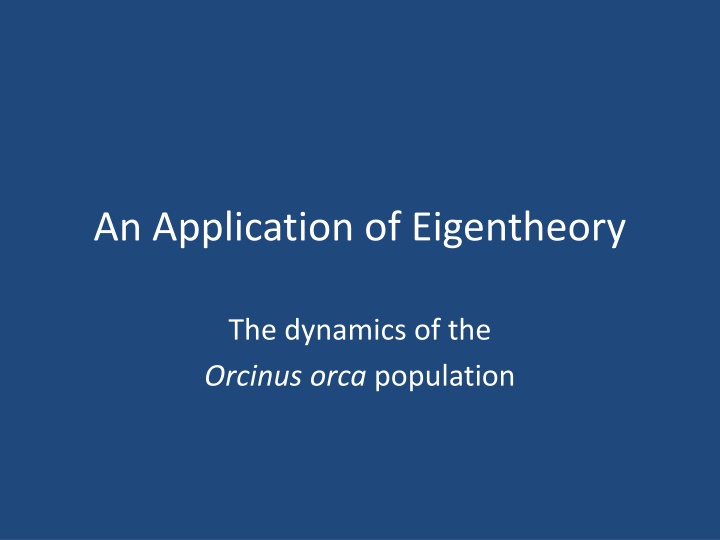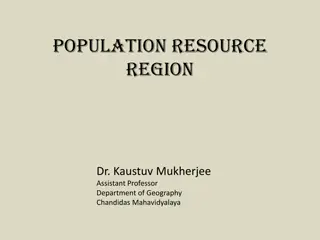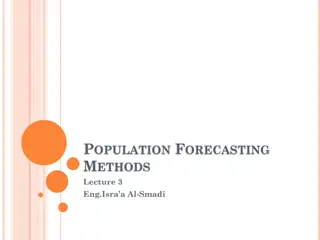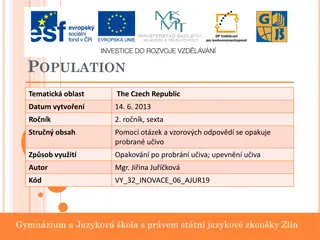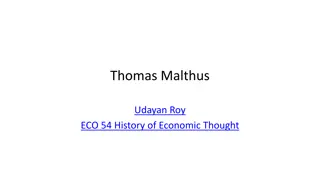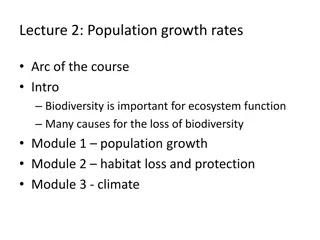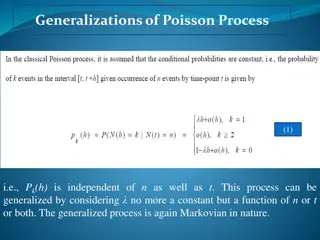Dynamics of Orcinus orca Population: An Application of Eigentheory
This study explores the dynamics of the Orcinus orca population using eigentheory models. It examines various age groups within the population and predicts their growth over a span of 100 years. Eigenvalues play a crucial role in understanding the evolution of the population dynamics.
Download Presentation

Please find below an Image/Link to download the presentation.
The content on the website is provided AS IS for your information and personal use only. It may not be sold, licensed, or shared on other websites without obtaining consent from the author.If you encounter any issues during the download, it is possible that the publisher has removed the file from their server.
You are allowed to download the files provided on this website for personal or commercial use, subject to the condition that they are used lawfully. All files are the property of their respective owners.
The content on the website is provided AS IS for your information and personal use only. It may not be sold, licensed, or shared on other websites without obtaining consent from the author.
E N D
Presentation Transcript
An Application of Eigentheory The dynamics of the Orcinus orca population
A model Yearling Juvenile Post- Mature Reproductive
A model 91.11% 97.75% Yearling Juvenile .43% 7.36% 11.32% Post- Mature Reproductive 4.52% 95.34% 98.04%
+ 0 0.0043 0.1132 0 0 0 1 k k Y J M P Y J M P + 0.9775 0.9111 0 0 0 1 k k = + 0.0736 0.9534 0 1 k k 91.11% + 0.0452 0.9804 1 k k 97.75% Yearling Juvenile Where : Yk = yearlings in year k Jk = juveniles in year k Mk = matures in year k Pk = post-matures in year k .43% 7.36% 11.32% Post- Reprod uctive Mature 4.52% 98.04% 95.34%
+ 0 0.0043 0.1132 0 0 0 1 k k Y J M P Y J M P + 0.9775 0.9111 0 0 0 1 k k = + 0.0736 0.9534 0 1 k k + 0.0452 0.9804 1 k k Suppose we begin with Y1 = 100 J1 = 100 M1 = 100 P1 = 100 What happens in 100 years?
+ 0 0.0043 0.1132 0 0 0 1 k k Y J M P Y J M P + 0.9775 0.9111 0 0 0 1 k k = + 0.0736 0.9534 0 1 k k + 0.0452 0.9804 1 k k Suppose we begin with Y1 = 100 J1 = 100 M1 = 100 P1 = 100 What happens in 100 years? 1800 1600 1400 1200 1000 800 600 400 200 0 0 10 20 30 40 50 60 70 80 90 100
+ 0 0.0043 0.1132 0 0 0 1 k k Y J M P Y J M P + 0.9775 0.9111 0 0 0 1 k k = + 0.0736 0.9534 0 1 k k + 0.0452 0.9804 1 k k Suppose we begin with Y1 = 100 J1 = 100 M1 = 100 P1 = 100 What happens in 100 years? 1800 1600 1400 1200 1000 800 600 Eigenvalues are 1.0254 0.9804 0.8342 0.0048 400 200 0 0 10 20 30 40 50 60 70 80 90 100
A new model 91.11% 40.00% 97.75% Yearling Juvenile .43% 7.36% 11.32% Post- Mature Reproductive 4.52% 95.34% 98.04%
+ 0 0.0043 0.1132 0 0 0 1 k k Y J M P Y J M P 0.4000 + 0.9775 0.9111 0 0 0 1 k k = + 0.0736 0.9534 0 1 k k 91.11% 40.00% + 0.0452 0.9804 1 k k 97.75% Yearling Juvenile Where : Yk = yearlings in year k Jk = juveniles in year k Mk = matures in year k Pk = post-matures in year k .43% 7.36% 11.32% Post- Reprod uctive Mature 4.52% 98.04% 95.34%
+ 0 0.0043 0.1132 0.9111 0.0736 0.9534 0 0 0 0 1 k k Y J M P Y J M P + 0.4 0 0 0 1 k k = + 1 k k + 0.0452 0.9804 1 k k Suppose we begin with Y1 = 100 J1 = 100 M1 = 100 P1 = 100 What happens in 100 years? 250 200 150 100 50 0 0 10 20 30 40 50 60 70 80 90 100
+ 0 0.0043 0.1132 0.9111 0.0736 0.9534 0 0 0 0 1 k k Y J M P Y J M P + 0.4 0 0 0 1 k k = + 1 k k + 0.0452 0.9804 1 k k Suppose we begin with Y1 = 100 J1 = 100 M1 = 100 P1 = 100 What happens in 100 years? 250 200 150 100 Eigenvalues are 0.9945 0.9804 0.8681 0.0020 50 0 0 10 20 30 40 50 60 70 80 90 100
And in 1000 years 250 200 150 100 50 0 0 100 200 300 400 500 600 700 800 900 1000
48.56% A third model 91.11% 40.00% 97.75% Yearling Juvenile .43% 7.36% 11.32% Post- Mature Reproductive 4.52% 95.34% 98.04%
+ 0 0.0043 0.1132 0 0 0 1 k k Y J M P Y J M P 0.4000 0.4856 0.9111 0 0 + 0 1 k k = + 91.11% 0.0736 0.9534 0 1 k k 48.56% + 0.0452 0.9804 1 k k 40.00% 97.75% Yearling Juvenile Where : Yk = yearlings in year k Jk = juveniles in year k Mk = matures in year k Pk = post-matures in year k .43% 7.36% 11.32% Post- Reprod uctive Mature 4.52% 98.04% 95.34%
+ 0 0 0.0043 0.1132 0.9111 0.0736 0.9534 0 0 0 0 0 0 1 k 1 k + Y J M P P Y J M P P 0.0043 0.1132 0 0 k k Y J M Y J M + 0.4 0 0 0 0 0 1 k 1 k + 0.4856 0.9111 0 k k = = + 1 k 1 k + 0.0736 0.9534 k k + 0.0452 0.9804 0.0452 0.9804 1 k 1 k + k k Suppose we begin with Y1 = 100 J1 = 100 M1 = 100 P1 = 100 What happens in 100 years? 300 250 200 150 100 Eigenvalues are 1.0000 0.9804 0.8621 0.0024 50 0 0 10 20 30 40 50 60 70 80 90 100
And in 1000 years 350 300 250 200 150 100 50 0 0 100 200 300 400 500 600 700 800 900 1000
An Application of Eigentheory Growth Rates of Computational Work
We have a problem whose computational work depends upon some size parameter n W(n+1) = W(n) + 2 W(n-1) + 3 W(n-2) for n= 3,4,
W(n+1) = W(n) + 2W(n-1) + 3W(n-2) for n= 3,4, We could represent this in matrix form as: ( 1) 0 0 3 1 0 2 0 1 1 ( ( 2) 1) W n W n W n W n W n W n = ( ) + ( 1) ( )
The eigenvalues of that matrix are: 2.3744 -0.6872 + 0.8895i -0.6872 - 0.8895i
The eigenvalues of that matrix are: 2.3744 -0.6872 + 0.8895i -0.6872 - 0.8895i Complex numbers
The eigenvalues of that matrix are: 2.3744 -0.6872 + 0.8895i -0.6872 - 0.8895i This means that W(n) = O(2.3744n) 10300 Semilog plot of W(n) starting with W(1) = W(2) = W(3) = 1 10250 10200 10150 10100 1050 100 0 100 200 300 400 500 600 700 800 900 1000
